Family : Cetoniidae

Text © Prof. Santi Longo

English translation by Mario Beltramini
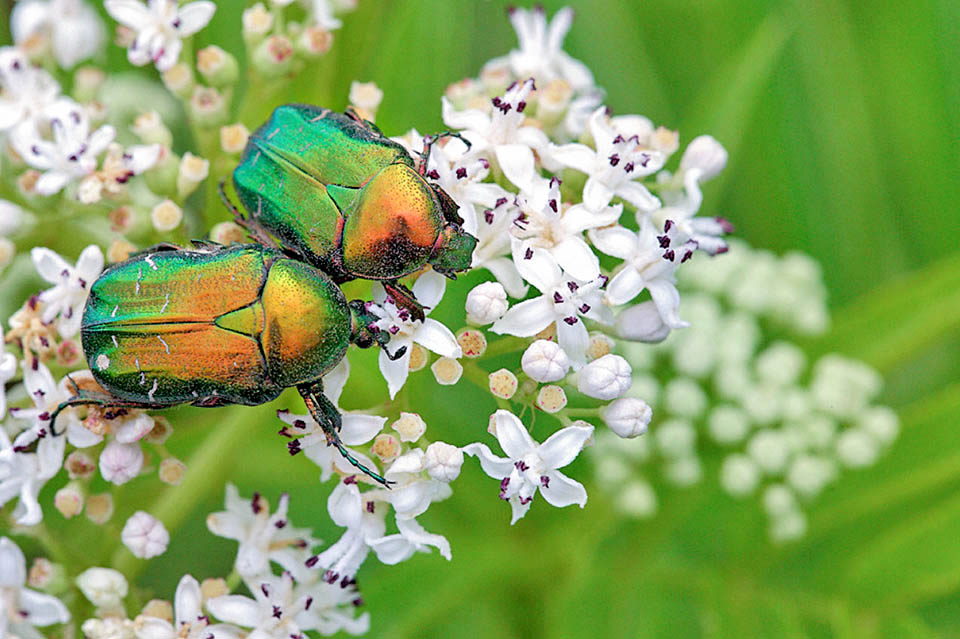
Cetonia aurata is present in the warm and temperate zones of central and southern Europe and in some North African and Asian zones © Erland Refling Nielsen
The Rose chafer or Green rose chafer, Cetonia aurata (Linnaeus, 1758), is a coleopteran belonging to the famil Cetoniidae that groups adults with a medium sized body, a bit depressed, with liveries having metallic reflections, without any evident sexual dimorphism.
Unlike the other coleopterans, the adults of this subfamily can spread their hind membranous wings without lifting the elytra as along the margin of these ones is present a hollow that allows it.
Moreover, the prothorax is integral with the margin of the elytra; the ventral part of the second segment extends ahead in a corniform appendage.
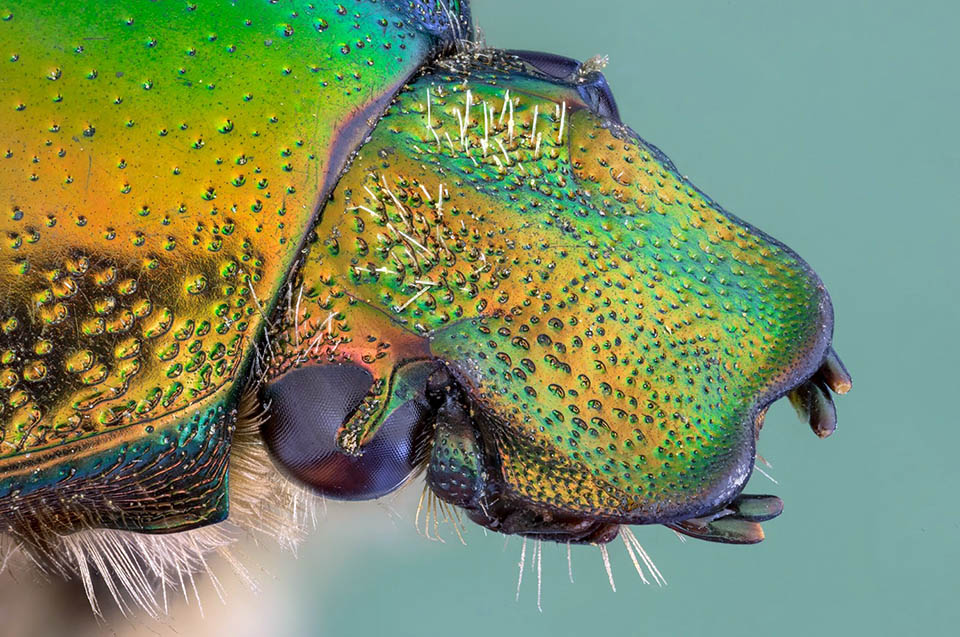
Head close-up. Iridescent metallic colour is the result of the interference between luminous rays reflected by superimposed microlamellae © Güray Dere
The larvae, of melolontoid or scarabaeiform type, are like those of the cockchafer (Melolontha melolontha) with the curved body of whitish colour, squat and hardly mobile. They have short thoracic legs and the last segments of the abdomen merged and enlarged, called pygidium. The arrangement of the bristles in this zone allows us to recognize the species.
They live in the soil at the expense of roots or of decaying organic matter keeping the body folded in the shape of the letter C and consequently called cirtosomatic.
The etymon of the genus Cetonia, created by Fabricius in 1775 is not sure: it could refer to the Greek term “ἔσθημα”, chitonia that means dress or to the adjective “χϑόνιος” (ctonio) underground.
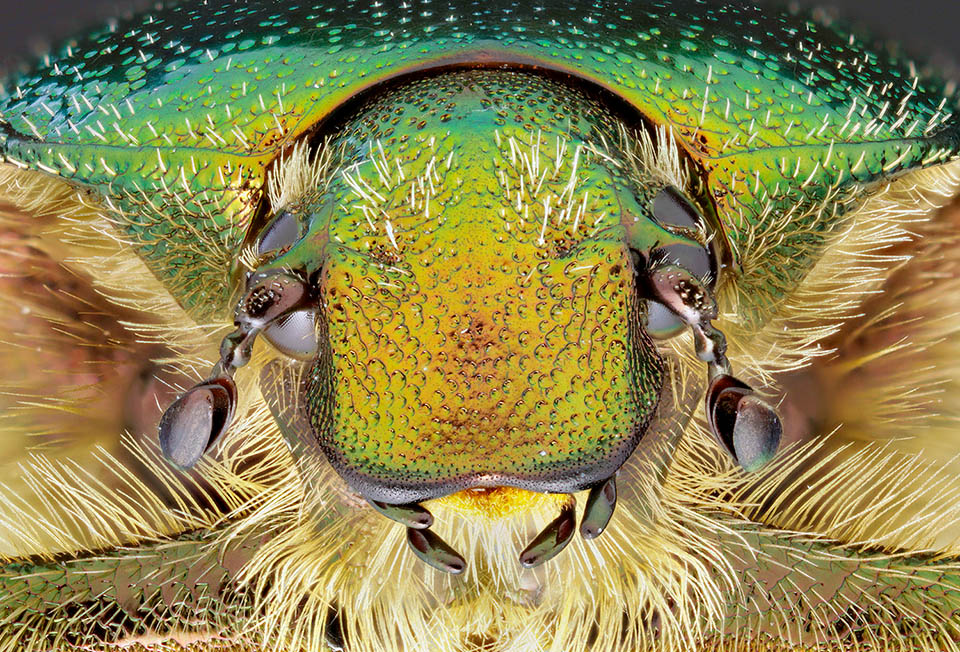
Frontal vision evidences the numerous hairs of ventral zone and lamellate antennae with the last articles that may be spread apart or merged like book pages © Kjell Nilsson
The etymology of aurata, golden in Latin, is clearer, with reference to the golden reflections of the tegument. In the first case the meaning should therefore be “golden dress”, in the second “golden underground” with reference to the underground life of the larvae and the emerging of the golden adults.
In old Egypt the Scarabaeidae were symbols of rebirth and of knowledge and were represented with open wings as well as closed with different meanings.
Zoogeography
Cetonia aurata is diffused in the warm and temperate zones of central and southern Europe and in some areas of North Africa and of Asia, where there have been described about forty species.
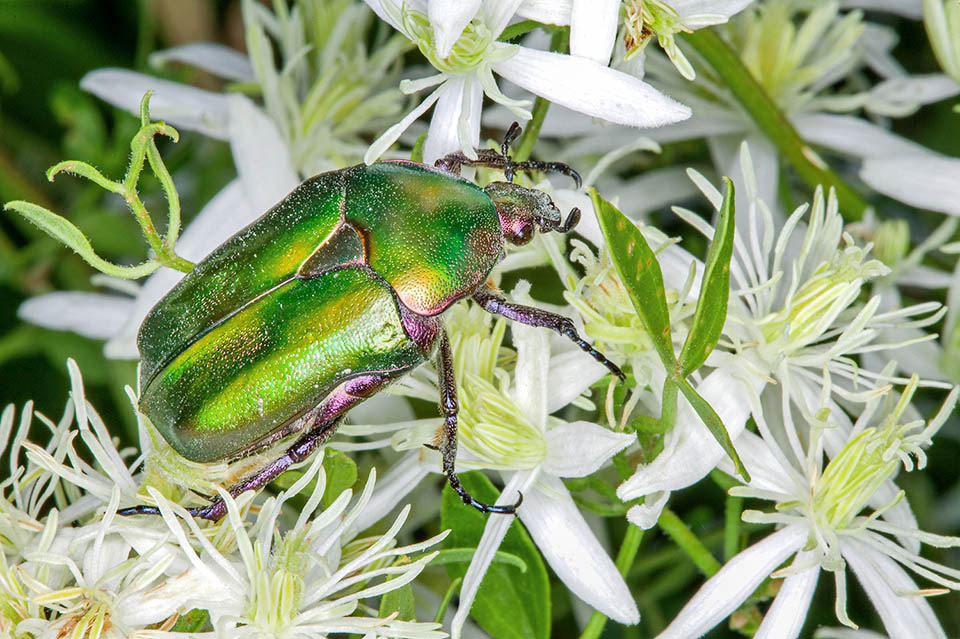
Adults feed on pollen and petals of flowers. The mouthpart, of masticatory type, has no robust jaws and they cannot gnaw the leaves © Giuseppe Mazza
Ecology-Habitat
The adults are floricultural and feed on pollen and petals of flowers.
With the mouthpart and with the legs equipped with teeth and nails, they mainly damage the roses and the flowers belonging to the genera Paeonia, Viburnum and Cotoneaster, contributing in return to the cross pollination.
The larvae live in the soil or in the cavities of dead trees where the eggs have been laid, nourishing of plant residues and of the rotting wood thanks to the symbiotic bacteria living in their intestine.
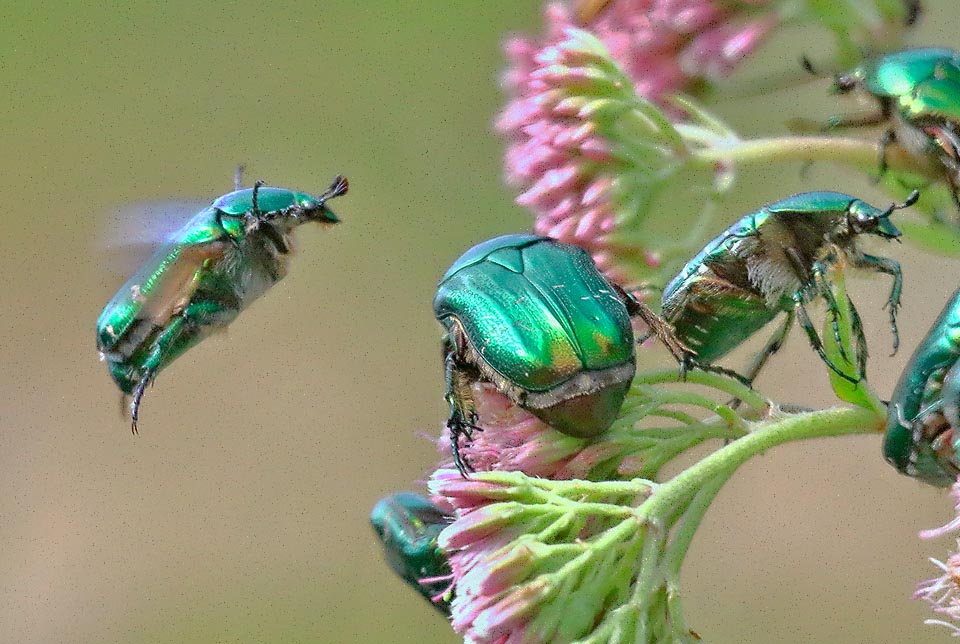
Cetonia dorate flyes without lifting the elytra. It is not rare to find groups of adults attracted by the flowers and by partners © Rade Marković
Often, they settle in the nests of ants (Formica rufa) that tolerate the presence of the big larvae that cooperate in cleaning up the nest by eating plant debris.
Morphophysiology
The adults have an about 2 cm long body and a metallic livery of golden pale green colour, often with bronze violet or copper tones.
The ventral part of the body is of a darker colour, often copper. The antennae are lamellate with the last articles that can be spread apart or joined like the pages of a book.
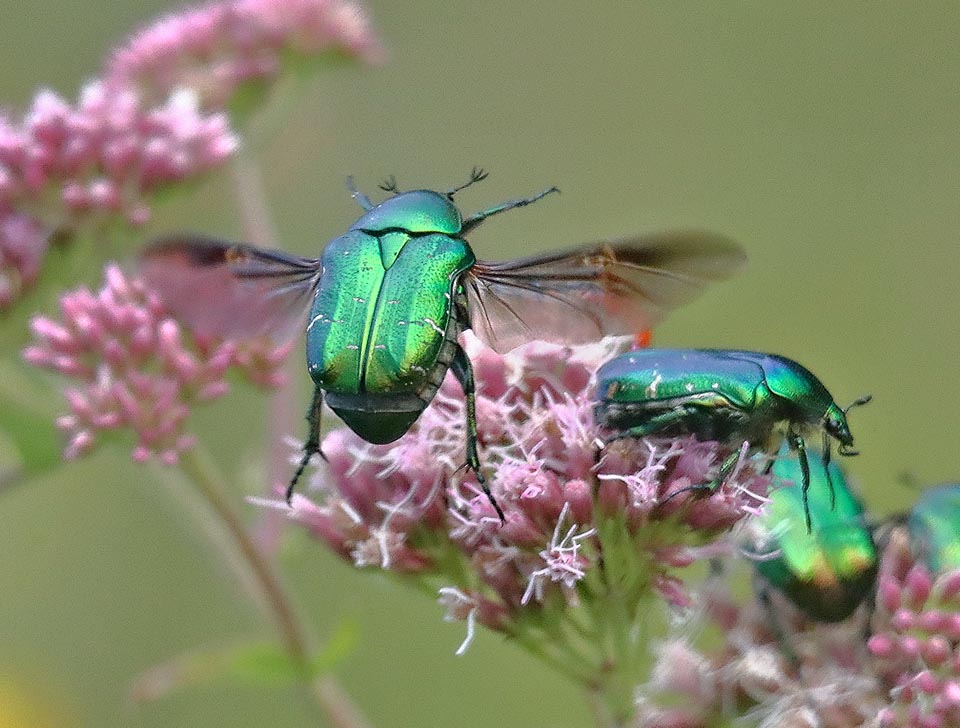
This male has the last articles of the antennae spread because has found and is following the scented trail of a female © Rade Marković
The mouthpart, of masticatory type, does not have strong jaws. Therefore, they can gnaw the petals but not the leaves.
The elytra, having metallic reflections, display some short, irregular, transversal whitish veins.
The livery varies on an individual level as well as of population. Some specimens have the first segment of the thorax reddish and green and bluish elytra, but also blue or black.
These colours are physical in nature and are defined structurally because they are the effect of the presence of a series of structures spaced a little more than the wavelength of the light.
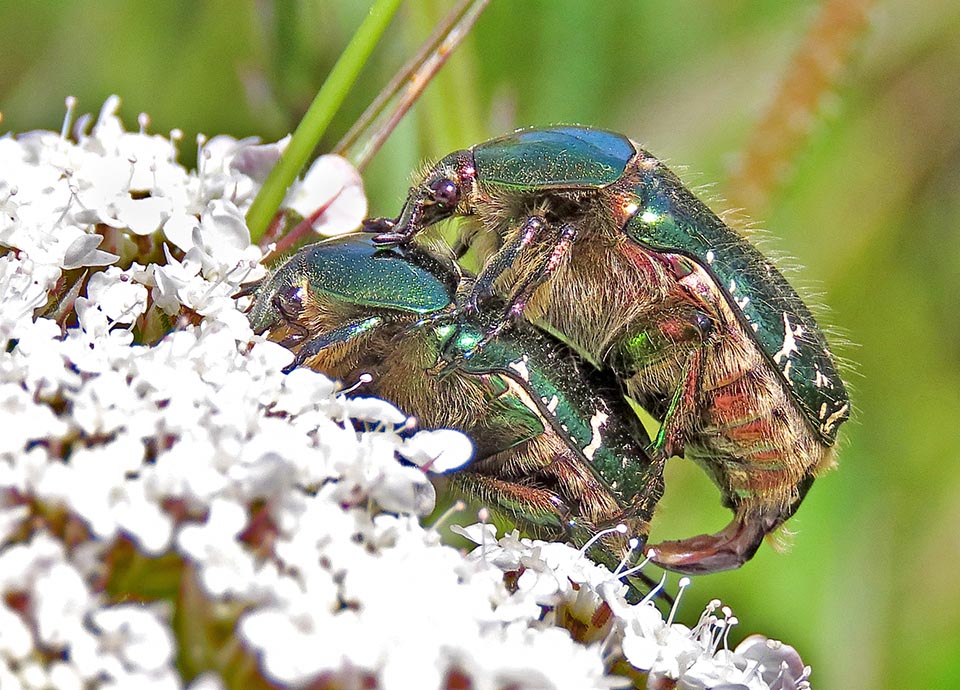
Mating occurs not too far. The females lay dozens of eggs in the ground or in the cavities of the trunks of old plants © Nick Smith
The iridescence is the outcome of the interference between the luminous rays reflected by the superimposed lamellae.
These premonitory or sematic, or aposematic, colourations, remind the predators the bad taste of their own body.
The whitish eggs have a spherical shape with about 1 mm of diametre.
The larvae have a stocky and big body, with thick dorsal folds. The head is small and of brown colour. Once completed its development the body measures 3 to 4 cm, is whitish, little arched, with numerous hairs.
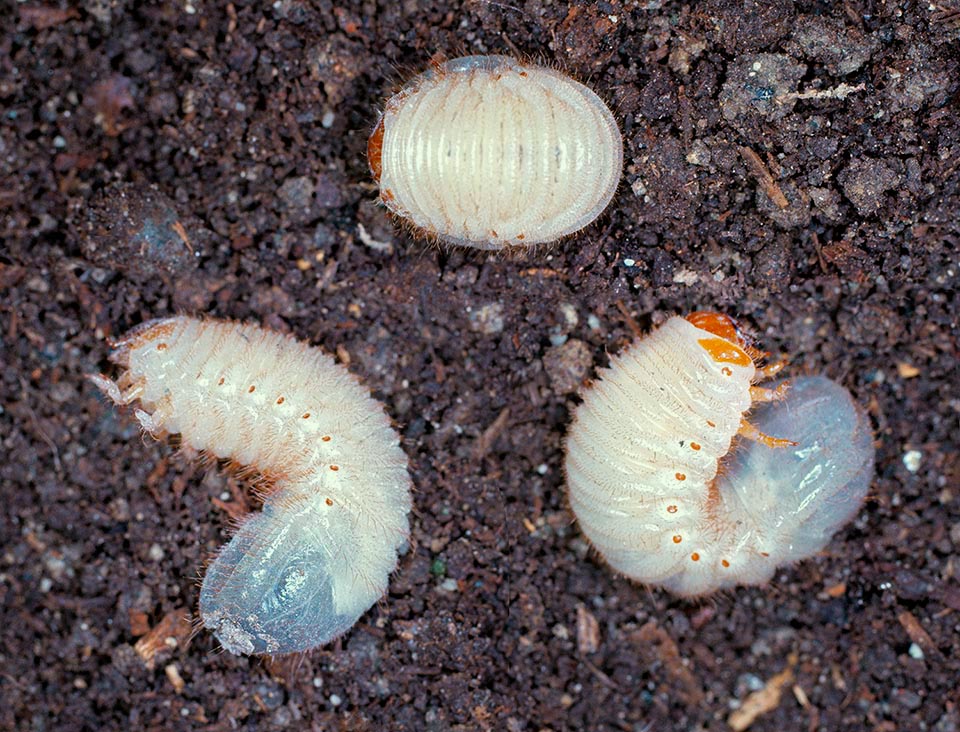
Three whitish larvae brought to light by moving a compost where they fed on debris. They measure 3-4 cm. On sides we note the yellow respiratory stigmas © G. Mazza
The legs are small. Along the lateral parts of the thorax and of the abdomen stand the respiratory stigmas of yellow colour.
The arrangement of the hairs present in the pygidium allows the recognition of the species.
The mature larva prepares a roundish pupal chamber, with a greater diametre of about 3 cm, cementing the earthy particles with faeces and salivary secretions. Inside it takes place the metamorphosis transforming in a pupa of adecto type, almost completely motionless.
The adult, after staying for some time in the pupal chamber, with its robust legs opens a passage and rises to the surface.
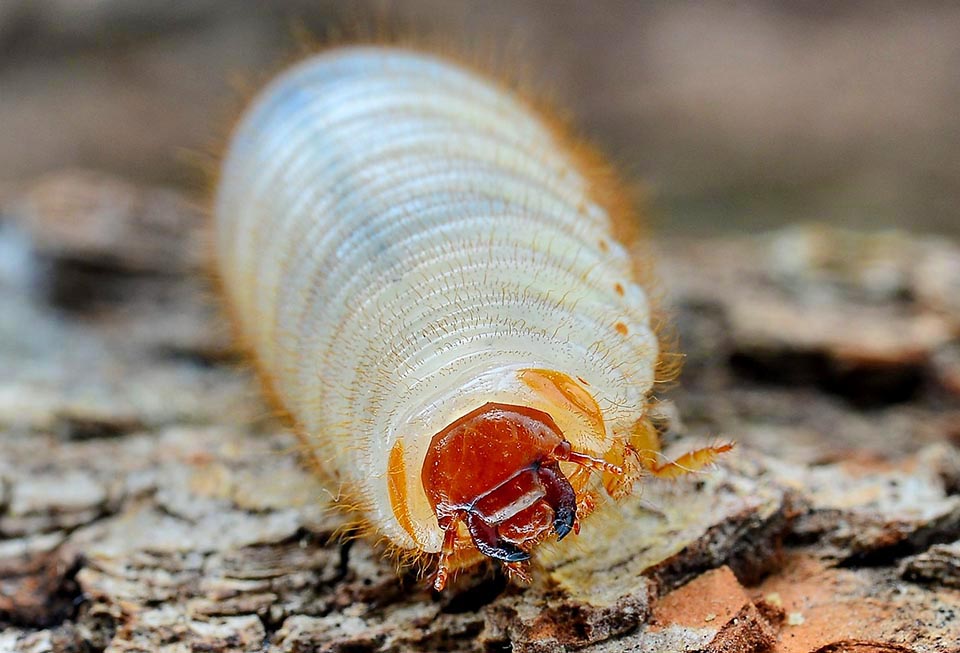
Head detail with the robust mandibles. The larvae are strictly detritivorous and unlike those of the Cockchafer do not eat roots © Ralf Bauer
Ethology-Reproductive Biology
The adults of the Cetonia aurata appear in June-July and after feeding on pollen and on floral organs proceed to mate. Occasionally they ingest the sugary liquids leaking from the wounds of the trunks of arboreal plants.
The females oviposit groups of a few dozen eggs in the soil or in the hollows of the trunks of old plants. The larval development completes usually in two years, but the duration depends on the environmental conditions. The larvae are strictly detritivorous and do not eat roots. When they live in the litter or in the compost, they carry on one annual generation thus validly contributing to the formation of humus.
The pupal stage is short and completes in the month of April, May.
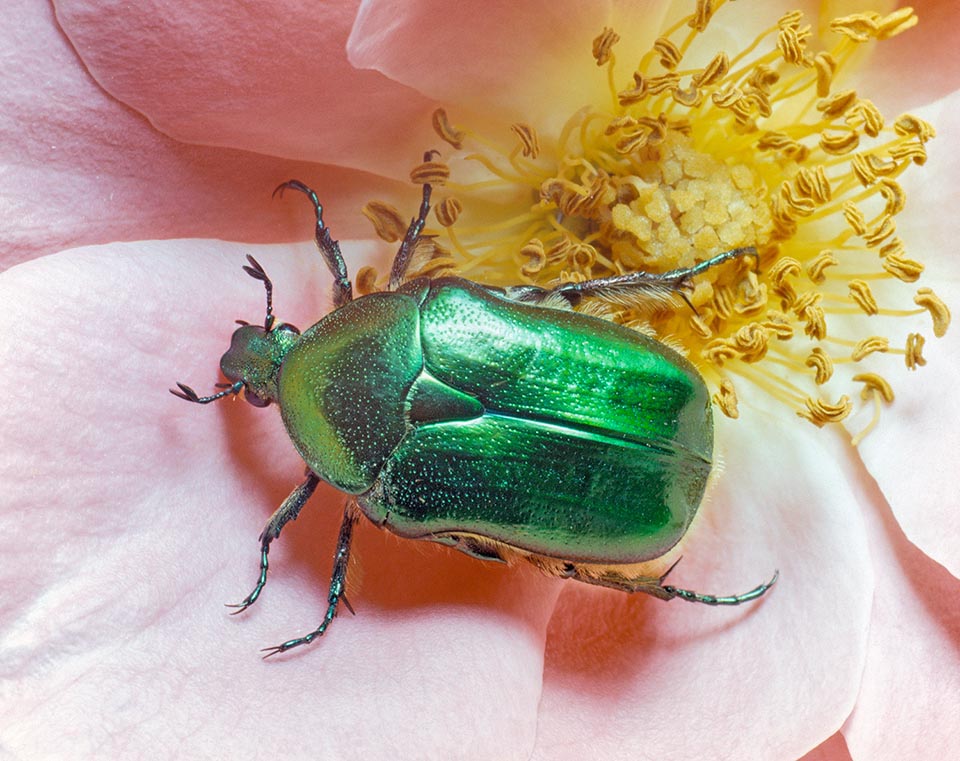
Adults appear in June-July. Their choice flowers are the roses, where they gnaw the tender petals and anthers rich in pollen © Giuseppe Mazza
The adults are active during the warmest hours of the day; during the first morning hours they keep almost motionless on the plants. If disturbed they drop to the ground in thanatosis, feigning death; moreover, they produce uric and formic acids that give their body an unpleasant taste, sickening for the possible predators.
In case of too numerous presences, recourse is done to their manual harvesting to avoid damages to the flowers and to the ripe fruits.
Synonyms
Scarabaeus auratus, Linnaeus, 1758.
→ For general notions about Coleoptera please click here.
→ To appreciate the biodiversity within the BEETLES please click here.
